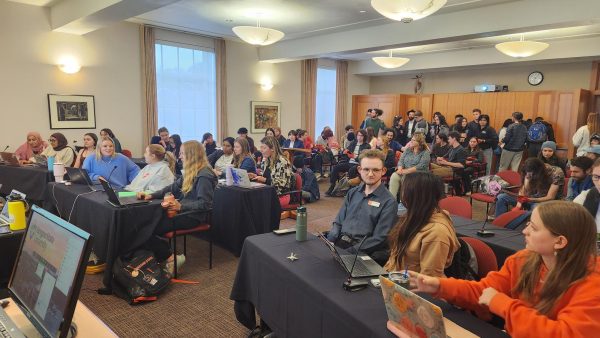Invasive stink bugs threaten Oregon’s $132 million hazelnut crop
This dramatic illustration shows a giant stink bug attacking crop fields as an onlooker screams in terror.
December 14, 2022
An invasive species of insect is creating a stink for Oregon’s agriculture.
While the jokes may write themselves, Brown Marmorated Stink Bugs, Halyomorpha halys, are no laughing matter, threatening hundreds of millions of dollars in crops statewide while experts seek control methods.
The Brown Marmorated Stink Bug is a species native to Asia, where, according to Max Ragozzino, a biological control entomologist with the Oregon Department of Agriculture, they’re also a pest. According to Ragozzino, in their native range, BMSBs damage tree fruit and vegetable crops, as well as making themselves a nuisance in people’s homes.
Ragozzino says the insect can feed on hundreds of plant species, will lay its eggs on non-plant materials such as plastic and fabric, and is known to overwinter in manmade environments, including shipping containers. These factors come together to make BMSBs an effective invasive species.
“We don’t know exactly how it first got to the U.S., but we think it was accidentally imported alongside other goods,” Ragozzino said.
According to Nik Wiman, an associate professor in the Oregon State University College of Agricultural Sciences, the first BMSB to be detected in Oregon was found in Portland in 2004. Wiman says OSU has been researching the bugs for a decade.
“OSU has been involved in research on BMSB since 2012,” Wiman said. “This was my first job at OSU, I went around the state and discovered that the insect was already becoming widely established around the state.”
This wide distribution of the pest is bad news for Oregon’s farmers and gardeners since, according to Wiman, over 170 BMSB host plants have been recorded in the U.S., with some of these plants being crops.
“They have piercing-sucking mouthparts and they feed on vegetative parts of their hosts (leaves, stems, etcetera), but they also target seeds, fruits, nuts and sometimes vegetables,” Wiman said.
Wiman says that, in particular, the damage caused by BMSBs is a significant problem for fruits and nuts. In Oregon, several economically significant crops are at risk for damage, among them the state’s apples, pears and hazelnuts.
Oregon produces the vast majority of the U.S. hazelnut crop, with almost 100% of the nation’s hazelnuts coming from the Beaver State, according to Oregon Department of Agriculture data.
The data also shows that in 2020, Oregon’s hazelnut production was valued at $132.3 million, making the nut the state’s tenth most valuable agricultural product. According to Michael Severeid, vice president of Sales and Marketing at Willamette Hazelnut, bug damage will not directly affect hazelnut prices, however there will still be an impact on producers.
“It will impact the marketability of this year’s crop,” Severeid said. “Processors will have longer run time to remove damaged kernels.”
Severeid says the stink bug problem for hazelnuts this year was the worst it’s been since 2019, in addition to a market unfavorable for hazelnut producers.
“Worldwide demand is soft and tree nut supply is greater than demand,” Severeid said.
The invasive insect isn’t only an issue for agriculture, either. Many of the bugs recorded host plants are ornamental, Wiman said, and according to the OSU College of Agriculture’s BMSB website, the species targets homes and businesses as locations to overwinter.
Since arriving in Oregon, BMSB populations have been able to grow unchecked partly because of the bug’s wide diet, according to Ragozzino, and partly because predators in the U.S. have been unable to keep up with the population growth.
“There are many native natural enemies that prey on BMSB,” Ragozzino said. “They prey on BMSB, and help contribute towards lowering BMSB populations, but alone, they can’t keep up with the nearly unchecked growth.”
According to Wiman, there are few animals that will attack an adult BMSB. However, Wiman says that younger BMSB, as well as eggs, are vulnerable to predation. One insect that takes advantage of this vulnerability is considered a promising method of controlling the stink bugs.
Trissolcus japonicus, better known as the samurai wasp, is a tiny wasp, just 1.5mm (0.06 inches) long, native to the same parts of Asia as the BMSB, according to an OSU extension office publication on the species.
The wasp lays its eggs inside BMSB eggs, which occur in 28-egg clusters, with wasps developing in affected BMSB eggs, killing the stink bug, according to a 2017 OSU press release.
While the samurai wasp is not native to the United States, it makes an ideal candidate for controlling BMSB populations because it restricts its egg-laying to BMSB eggs, according to the OSU extension office publication.
According to Wiman, OSU first received samurai wasps to study in 2012, with evaluations beginning in Richardson Hall’s quarantine facility. Ragozzino said that this was the same year the ODA began research on using the wasps as a method of control, along with several other agencies.
“Research was primarily focused on finding out what species of insects the samurai wasp would attack,” Ragozzino said, “and determining if we thought it was a risk to other Oregon insect species.”
Although there were plans to request permission to introduce the wasp, according to Wiman, the wasp was discovered in Vancouver, Washington in 2015, and had reached Portland a year later in 2016.
“We were considering petitioning the regulatory agencies for permission to release the wasp based on the research performed,” Wiman said, “the wasps got here on their own.”
According to Ragozzino, the samurai wasp is suspected to have reached the U.S. the same way as the stink bugs, inside accidentally-imported eggs.
While the wasps have introduced themselves to Oregon, the ODA has been bolstering their numbers, and has been rearing them en masse since 2020 to release statewide, Ragozzino said.
While samurai wasps have been found in BMSB eggs found in the wild, according to Ragozzino, it’s just too early to tell exactly what impact the wasps will have.
“Based on other biological control programs done in the past, we won’t know the true impact of the samurai wasp for at least 10 years after initial releases,” Ragozzino said.
This means that the effects of the introduced wasps can’t be known until at least 2027, and Ragozzino stressed that it may be even later than that.
“Some biological control programs take off quickly, and show results sooner, others take even longer,” Ragozzino said. “It depends on a huge variety of environmental and biological factors.”
While researchers monitor the wasp project, experts are exploring other methods of controlling the BMSB outbreak.
“We put a lot of effort into developing effective monitoring strategies, which involved developing traps and pheromone lures that are effective,” Wiman said.
Wiman also said that research was being conducted to find links between data collected from BMSB trapping and the probability of damage to crops.
“This would give growers a tool to assess the threat and then only spray when needed,” said Wiman, adding that while results are encouraging, there was a lot of research still needed.
According to Severeid, insecticide spraying is a method that hazelnut producers currently employ to limit BMSB damage. Using pheromone lures to attract the stink bugs to a specific area before killing them, rather than spraying entire orchards, could be an effective alternative, Wiman said.
According to Wiman, research has shifted to focusing on learning how to predict BMSB population cycles.
“Some years we may not need to worry about crops being damaged but in other seasons the risk level is much higher,” Wiman said, “we need to better understand how this works so that we can inform growers about risk.”
Both the OSU extension service and the USDA-backed Stop BMSB websites offer further information about BMSB management options, and Ragozzino recommends those with stink bug problems consider the information available to them.
“Controlling any pest, including BMSB, can be difficult, “Ragozzino said, “managing BMSB requires knowledge of your crop or home setting, and assessing the tools at your disposal.”

























































































































